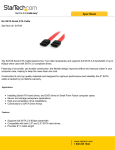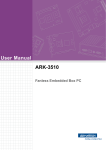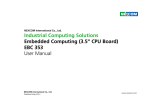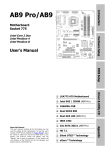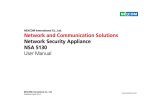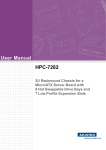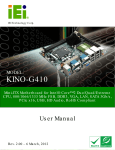Download User Manual
Transcript
Embedded Board BNX-M67 Always at the forefront of innovation User Manual 1 Copyright This publication contains information that is protected by copyright. No part of it may be reproduced in any form or by any means or used to make any transformation adaptation without the prior written permission from the copyright holders. This publication is provided for informational purposes only. The manufacturer makes no representations or warranties with respect to the contents or use of this manual and specifically disclaims any express or implied warranties of merchantability or fitness for any particular purpose. The user will assume the entire risk of the use or the results of the use of this document. Further, the manufacturer reserves the right to revise this publication and make changes to its contents at any time, without obligation to notify any person or entity of such revisions or changes. © 2011. All Rights Reserved. Trademarks All trademarks and registered trademarks of products appearing in this manual are the properties of their respective holders. FCC and DOC Statement on Class A This equipment has been tested and found to comply with the limits for a Class A digital device, pursuant to Part 15 of the FCC rules. These limits are designed to provide reasonable protection against harmful interference when the equipment is operated in a residential installation. This equipment generates, uses, and can radiate radio frequency energy and, if not installed and used in accordance with the instruction manual, may cause harmful interference to radio communications. However, there is no guarantee that interference will not occur in a particular installation. If this equipment does cause harmful interference to radio or television reception, which can be determined by turning the equipment off and on, the user is encouraged to try to correct the interference by one or more of the following measures: Reorient or relocate the receiving antenna. Increase the separation between the equipment and the receiver. Connect the equipment into an outlet on a circuit different from that to which the receiver is connected. Consult the dealer or an experienced radio TV technician for help. Notice: 1. The changes or modifications not expressly approved by the party responsible for compliance could void the user’s authority to operate the equipment. 2. Shielded interface cables must be used in order to comply with the emission limits. 2 Warranty 1. Warranty does not cover damages or failures that are raised from misuse of the product, inability to use the product, unauthorized replacement or alteration of components and product specifications. 2. The warranty is void if the product has been subject to physical abuse, improper installation, modification, accidents or unauthorized repair of the product. 3. Unless otherwise instructed in this user’s manual, the user may not, under any circumstances, attempt to perform service, adjustments or repairs on the product, whether in or out of warranty. It must be returned to the purchase point, factory or authorized service agency for all such work. 4. We will not be liable for any indirect, special, incidental or consequential damages to the product that has been modified or altered. Static Electricity Precautions It is quite easy to inadvertently damage your PC, system board, components or devices even before installing them in your system unit. Static electrical discharge can damage computer components without causing any signs of physical damage. You must take extra care in handling them to ensure against electrostatic build-up. 1. To prevent electrostatic build-up, leave the system board in its anti-static bag until you are ready to install it. 2. Wear an antistatic wrist strap. 3. Do all preparation work on a static-free surface. 4. Hold the device only by its edges. Be careful not to touch any of the components, contacts or connections. 5. Avoid touching the pins or contacts on all modules and connectors. Hold modules or connectors by their ends. Important: Electrostatic discharge (ESD) can damage your processor, disk drive and other components. Perform the upgrade instruction procedures described at an ESD workstation only. If such a station is not available, you can provide some ESD protection by wearing an antistatic wrist strap and attaching it to a metal part of the system chassis. If a wrist strap is unavailable, establish and maintain contact with the system chassis throughout any procedures requiring ESD protection. 3 Safety Measures To avoid damage to the system: • Use the correct AC input voltage range. To reduce the risk of electric shock: • Unplug the power cord before removing the system chassis cover for installation or servicing. After installation or servicing, cover the system chassis before plugging the power cord. Battery: • Danger of explosion if battery incorrectly replaced. • Replace only with the same or equivalent type recommend by the manufacturer. • Dispose of used batteries according to local ordinance. Before Using the System Before using the system, prepare basic system components. If the system comes as a barebone; that is, none of the key components, including processor, memory, and hard drive has been pre-installed as part of your purchase, you will need to at least ensure a compatible counterpart is located and installed. You will also need a few external system peripherals intended for the use of the system, a common pool with at least a keyboard, a mouse, and a monitor is thus suggested. 4 Table of Content Copyright .................................................................................................................................................................... 2 Trademarks .................................................................................................................................................................... 2 FCC and DOC Statement On Class A.............................................................................................................................. 2 Warranty ........................................................................................................................................................................ 3 Static Electricity Precautions ......................................................................................................................................... 3 Safety Measures ............................................................................................................................................................ 4 Before Using the System Board ..................................................................................................................................... 4 Table of Content ............................................................................................................................................................ 5 Chapter 1 General Information 1.1 Main Feature ........................................................................................................................................................... 7 1.2 Specifications ....................................................................................................................................................... 8 1.3 Board Layout ..................................................................................................................................................... 9 Chapter 2 Jumper Setting 2.1 Before You Begin ...................................................................................................................................... 11 2.2 Precautions......................................................................................................................................................... 11 2.3 Setting Jumpers .................................................................................................................................................. 12 2.4 Back Panel Connectors ....................................................................................................................................... 13 2.5 Location of Jumpers and Connectors.............................................................................................................. 14 Chapter 3 Operation 3.1 System Memory .............................................................................................................................................. 26 3.2 Installing Memory ...................................................................................................................................... 26 3.3 Installing LGA1155 Intel® Core-i CPU, Heat Sink, and Fan ............................................................................... 28 3.4 Adding Power Connectors .............................................................................................................................. 31 3.5 Adding PCIe/PCI Cards .................................................................................................................................... 32 3.6 Installing a PCI Express Mini Card in the Full-Mini Card Slot .......................................................................... 33 Chapter 4 BIOS Setup 4.1 Entering Setup ................................................................................................................................................ 36 4.2 Getting Help .................................................................................................................................................... 36 4.3 Control Keys .................................................................................................................................................... 36 4.4 The Main Menu ............................................................................................................................................... 37 4.5 The Advanced Menu........................................................................................................................................ 38 4.6 The Chipset Menu..................................................................................................................................................... 40 4.7 The Boot Menu................................................................................................................................................ 41 4.8 The Security Menu .......................................................................................................................................... 42 4.9 The Save & Exit Menu ...................................................................................................................................... 43 5 Chapter 1 General Information 6 1.1 Main Feature Micro-ATX System Board BNX-M67 is a standard Micro-ATX motherboard featuring Intel® Q67 PCH chipset supports Intel® Gen-2 Core™ processor and four Dual Channel DDR3 DIMM slots up to 16GB DDR3 1066/1333MHz SDRAM with Non-ECC support and integrated HD graphic controller. Intel® Gen-2 LGA1155 Sandybridge Processor Four DDR3 RAM Slots up to 16GB Eight SATA Ports: 6* SATA 2.0 + 2* SATA 3.0 Support Intel® RAID-0/1/5/10 Function Three Display Ports: DB15 VGA, DVI-D, and HDMI Two Series Ports: One supporting RS-232/422/485 Ten USB 2.0 ports: Four Edge Ports + Six Internal Ports Two Intel® GbE LAN Ports 1* PCIe X16 2.0 Slot 1* full-sized miniPCIe Slot 7 1.2 Specifications Core Engine Chipset Intel® Q67 PCH Processor Support Intel® Gen-2 Core i3, i5, i7, Pentium® , Celeron® Processor Single LGA1155 Processor Socket Ethernet Memory 4x DDR3 1066/1333 DIMM Slots, up to 16GB, Non-ECC/Non-Buffered Memory Module Display Intel® HD Graphics 2000 Controller Onboard 1x Intel® 82579LM and 1x Intel® 82583V PCIe GbE Controllers 2x LAN LED Pin Headers Storage Expansion Edge I/O Internal I/O Other Environment Mechanical SATA 6x SATA2 + 2x SATA3 Ports, support RAID-0/1/5/10 PCIe X16 1x miniPCIe 1x Full-sized Display 1x DB15 VGA + 1x DVI-D + 1x HDMI USB 4x USB 2.0 LAN 2x RJ45 GbE Audio 3x Audio Jacks Front Panel 1x Front Panel Switch/LED Header COM 1x RS-232 + 1x RS-232/422/485 Pin Header USB 6x USB 2.0 Pin Headers GPIO 8x 5V TTL GPIO Pin Header LED 2x LAN LED Fan 3x Fan Connectors H/W Monitoring Monitor temperature, voltage, and fan speed, auto-throttling control at CPU overheat WDT 1 min increment from 1 to 255 min, 1 sec increment from 1 to 255 sec Operating Temp. 0oC ~ 60oC Storage Temp. -20oC ~ 70oC Humidity 10% ~ 90% (Non-Condensing) Dimension 244mm (W) x 244mm (D) 8 1.3 Board Layout Figure 1.1: Board Layout of BNX-M67 9 Chapter 2 Preparation 10 2.1 Before You Begin A stable and clean working environment are essential. Dust and dirt can get into components and cause a malfunction. Use containers to keep small components separated. Adequate lighting and proper tools can prevent you from accidentally damaging the internal components. Most of the procedures that follow require only a few simple tools, including the following: A Philips screwdriver A flat-tipped screwdriver A set of jewelers Screwdrivers A grounding strap An anti-static pad Using your fingers can disconnect most of the connections. It is recommended that you do not use needle-nosed pliers to disconnect connections as these can damage the soft metal or plastic parts of the connectors. Before working on internal components, make sure that the power is off. Ground yourself before touching any internal components, by touching a metal object. Static electricity can damage many of the electronic components. Humid environment tend to have less static electricity than dry environments. A grounding strap is warranted whenever danger of static electricity exists. Computer components and electronic circuit boards can be damaged by discharges of static electricity. Working on the computers that are still connected to a power supply can be extremely dangerous. Follow the guidelines below to avoid damage to your computer or yourself: Always disconnect the unit from the power outlet whenever you are working inside the case. If possible, wear a grounded wrist strap when you are working inside the computer case. Alternatively, discharge any static electricity by touching the bare metal chassis of the unit case, or the bare metal body of any other grounded appliance. Hold electronic circuit boards by the edges only. Never touch the components on the board unless it is necessary to do so. Do not flex or stress the circuit board. Leave all components inside the static-proof packaging that they shipped with until they are ready for installation. Use correct screws and do not over tighten screws. 11 2.3 A jumper is the simplest kind of electric switch. It consists of two metal pins and a cap. When setting the jumpers, ensure that the jumper caps are placed on the correct pins. When the jumper cap is placed on both pins, the jumper is SHORT. If you remove the jumper cap, or place the jumper cap on just one pin, the jumper is OPEN. Please see the following illustrations The illustrations on the right show a 2-pin jumper. When the jumper cap is placed on both pins, the jumper is SHORT. If you remove the jumper cap, or place the jumper cap on just one pin, the jumper is OPEN. Open (Off) Short (On) These illustrations show a 3-pin jumper. Pins 1 and 2 are SHORT. Table 2-1: Setting Jumpers 12 2.4 Back Panel Connectors 1. 2. 3. 4. 5. 6. 7. 8. 9. 10. Line-In Jack LAN1 LAN2 DB15 VGA DVI HDMI 2* USB 2.0 2* USB 2.0 Microphone Jack Line-Out Jack 13 2.5 Locations Of Jumpers and Connectors 14 List of Onboard Connectors CON2 CON3 CON4 CON5 Fan1 J2 J3 J4 J5 JP3 JP6 JP7 JP8 JP9 JP11 JP12 JP14 JP18 CN1 CN2 CN3 CN5 CN6 CN7 CN8 CN10 CN11 CN12 CN14 CN15 CN16 CN20 CN22 Edge LAN2 & USB2/3 24-pin ATX Power Connector Edge LAN1 & USB0/1 2x2 +12Vdc Power Connector CPU Fan PS/2 Keyboard & Mouse System Fan System Fan Edge HDMI USB8/USB9 USB6/USB7 Clear CMOS Jumper ME Clear Jumper USB4/USB5 Front Panel LED & Switch 4in/4out GPIO PCIe X16 Slot AT/ATX Jumper SATA1 (3.0) SATA4 (2.0) SATA3 (2.0) miniPCIe SATA5 (2.0) SATA2 (2.0) SATA0 (3.0) miniPCIe COM1 COM2 Edge Audio Jack SATA7 (2.0) SATA8 (2.0) USB 3.0 Edge VGA & DVI-D 15 2.6 Jumpers ► Clear CMOS Jumper JP7 Pin 1-2 On 2-3 On Definition Normal (Default) Clear CMOS ► ME Clear Jumper JP8 Pin 1-2 On 2-3 On Definition Normal (Default) Clear ME ► Power Mode Selection Jumper JP18 Pin 1-2 On 2-3 On Definition ATX (Default) AT 16 2.7 Internal Connectors VGA + DV-D CN22 Pin 1 3 5 7 9 11 13 15 17 19 21 23 C1 C3 C5A MH1 25 27 29 31 33 35 37 39 MH3 Definition DVI_DATA2_N GND NC DVI_CTRL_DATA DVI_DATA1_N GND NC GND DVI_DATA0_N GND NC DVI_CLK_P NC NC GND Chassis_GND2 RED_VGA BLUE_VGA GND GND GND GND HSYNC_VGA DDC_CLK_VGA Chassis_GND2 Jack Blue Green Pink Definition Line-In (Blue) Line-Out (Green) Mic-In (Pink) Pin 2 4 6 8 10 12 14 16 18 20 22 24 C2 C4 C5B MH2 26 28 30 32 34 36 38 Definition DVI_DATA2_P NC DVI_CTRL_CLK NC DVI_DATA1_P NC DVI_PWR_S_VCC5 DVI_HPDET DVI_DATA0_P NC NC DVI_CLK_N NC NC GND Chassis_GND2 GREEN_VGA GND GND GND GND DDC_DATA_VGA VSYNC_VGA MH4 Chassis_GND2 Audio Jack CN14 17 LAN1 & USB0/USB1 CON4 Pin 1 3 5 7 9 11 13 15 17 19 21 23 25 27 Definition P5V_USB USBP P5V_USB USBP LANTXDP0 LANTXDP1 LANTXDP2 LANTXDP3 LAN_LED1P LAN_LINK Chassis_GND1 Chassis_GND1 Chassis_GND1 Chassis_GND1 Pin 2 4 6 8 10 12 14 16 18 20 22 24 26 28 Definition USBN GND USBN GND LANTXDN0 LANTXDN1 LANTXDN2 LANTXDN3 LAN_LED_LNK#_ACT LANLINKMIX Chassis_GND1 Chassis_GND1 Chassis_GND1 Chassis_GND1 Pin 1 3 5 7 9 11 13 15 17 19 21 23 25 27 Definition P5V_USB USBP P5V_USB USBP LANTXDP0 LANTXDP1 LANTXDP2 LANTXDP3 LAN_LED1P LAN_LINK Chassis_GND1 Chassis_GND1 Chassis_GND1 Chassis_GND1 Pin 2 4 6 8 10 12 14 16 18 20 22 24 26 28 Definition USBN GND USBN GND LANTXDN0 LANTXDN1 LANTXDN2 LANTXDN3 LAN_LED_LNK#_ACT LANLINKMIX Chassis_GND1 Chassis_GND1 Chassis_GND1 Chassis_GND1 LAN2 & USB2/USB3 CON2 18 CPU Fan Connector: FAN1 Pin 1 3 Definition GND FAN_TAC1 Pin 2 4 Definition +12V FAN_CTL1 System Fan Connector J3/J4 Pin 1 2 3 Definition GND +12V SENSE 2x2 +12Vdc Power Connector CON5 Pin 1 2 3 4 Definition GND GND +12V +12V USB 2.0 Connector JP9 (USB4, USB5)/JP6 (USB6, USB7)/JP3 (USB8, USB9) Pin 1 3 5 7 Definition 5VDUAL DATA0_N DATA0_P GND Pin 2 4 6 8 10 Definition 5VDUAL DATA1_N DATA1_P GND NC 19 24-pin ATX Power Connector CON3 Pin 1 3 5 7 9 11 13 15 17 19 21 23 Definition VCC3 GND GND GND 5VSB VCC12 VCC3 GND GND GND VCC5 VCC5 Pin 2 4 6 8 10 12 14 16 18 20 22 24 Definition VCC3 VCC5 VCC5 ATXPWROK VCC12 VCC3 -12V ATX_PS_ON_N GND NA VCC5 GND Pin 1 3 5 7 9 11 Definition SIO_GPI_80 SIO_GPI_82 SIO_GPO_84 SIO_GPO_86 +3.3V GND Pin 2 4 6 8 10 12 Definition SIO_GPI_81 SIO_GPI_83 SIO_GPO_85 SIO_GPO_87 +3.3V GND Pin 1 3 5 7 9 Definition DCD TXD GND RTS RI Pin 2 4 6 8 10 Definition RXD DTR DSR CTS RXD GPIO Connector JP12 COM1 (RS-232) Connector CN11 20 COM2 (RS-232/422/485) Connector CN12 Pin 1 3 5 7 9 Definition DCD/RS422_TX-/RS485_TXD/RS422_RX+ GND RTS/RS422_RTS+ RI/RS422_CTS- Pin 2 4 6 8 10 Definition RXD/RS422_TX+/RS485_+ DTR/RS422_RXDSR/RS422_RTSCTS/RS422_CTS+ RXD/RS422_TX+/RS485_+ Definition SATA_LED_P SATA_LED_N GND RST_BTN_N NC Pin 2 4 6 8 Definition PWR_LED_P GND BTN_A# GND Definition +5V Mouse Clock Mouse Data Pin 4 5 6 Definition Keyboard Data Keyboard Clock GND Front Panel Connector JP11 Pin 1 3 5 7 9 Keyboard and Mouse Connector J2 Pin 1 2 3 SATA3 Port Connector CN8 (SATA0)/CN1 (SATA1) Pin 1 2 3 4 5 6 7 Definition GND TXP TXN GND RXN RXP GND 21 SATA2 Port Connector CN7 (SATA2)/CN3 (SATA3)/CN2 (SATA4)/CN6 (SATA5) Pin 1 2 3 4 5 6 7 Definition GND TXP TXN GND RXN RXP GND PCIEX1 to SATA2 Port Connector CN15 (SATA7)/CN16 (SATA8) By Silicon Image 3132 PCIE to SATA Chip Pin 1 2 3 4 5 6 7 Definition GND TXP TXN GND RXN RXP GND HDMI J5 Pin 1 3 5 7 9 11 13 15 17 19 MH2 MH4 Definition HDMI_DATA2_P HDMI_DATA2_N GND HDMI_DATA0_P HDMI_DATA0_N GND NC HDMI_CTRL_CLK GND HDMI_HPD_R Chassis_GND1 Chassis_GND1 Pin 2 4 6 8 10 12 14 16 18 MH1 MH3 Definition GND HDMI_DATA1_P HDMI_DATA1_N GND HDMI_CLK_P HDMI_CLK_N NC HDMI_CTRL_DATA HDMI_VCC5 Chassis_GND1 Chassis_GND1 22 miniPCIe CN10 Pin 1 3 5 7 9 11 13 15 17 19 21 23 25 27 29 31 33 35 37 39 41 43 45 47 49 51 MH1 MH3 MH5 Definition WAKE_N NC NC MINICARD1CLKREQ# GND CK_PE_100M_Mini_DN CK_PE_100M_Mini_DP GND NC NC GND PCIE_RXN7_MINI PCIE_RXP7_MINI GND GND PCIE_TXN7_MINI PCIE_TXP7_MINI GND GND 3VSB_MINI1 3VSB_MINI1 GND NC NC NC NC GND GND GND Pin 2 4 6 8 10 12 14 16 18 20 22 24 26 28 30 32 34 36 38 40 42 44 46 48 50 52 MH2 MH4 MH6 Definition 3VSB_MINI1 GND P1V5_MINI1 GND GND GND GND GND GND MINICARD1DIS# PLTRST_PCIE1_N 3VSB_MINI1 GND P1V5_MINI1 SMB_CLK_MAIN SMB_DATA_MAIN GND USB_10N USB_10P GND NC NC NC P1V5_MINI1 GND 3VSB_MINI1 GND GND GND LAN1/LAN2 Active LED Pin Header JP20 Pin 1 2 Definition Pin LAN1_LED_LNK#_ACT 3 GND 4 Definition LAN2_LED_LNK#_ACT GND 23 PCIe X16 Slot JP14 Pin 1 2 3 4 5 6 7 8 9 10 11 12 13 14 15 16 17 18 19 20 21 22 23 24 25 26 27 28 29 30 31 32 33 34 35 36 37 Definition (B) +12 volt power +12 volt power +12 volt power Ground SMBus clock SMBus data Ground +3.3 volt power NC 3.3VSB WAKE# Reserved Ground TXP0 TXN0 Ground PRSNT2# Ground TXP1 TXN1 Ground Ground TXP2 TXN2 Ground Ground TXP3 TXN3 Ground Reserved PRSNT2# Ground TXP4 TXN4 Ground Ground TXP5 Definition (A) GND +12 volt power +12 volt power Ground PEG_TCK PEG_TDI NC PEG_TMS 3.3v volt power 3.3v volt power PE_RESEET# Ground REFCLK_P REFCLK_N Ground RXP0 RXN0 Ground NC Ground RXP1 RXN1 Ground Ground RXP2 RXN2 Ground Ground RXP3 RXN3 Ground NC NC Ground RXP4 RXN4 Ground 24 Chapter 3 Operation 25 3.1 System Memory BNX-M67 has Intel® Q67 chipset built-in, and supports dual channel non-ECC, un-buffered DDR31066/1333/1600MHz memory modules. Four DIMM slots support up to 16GB Memory Capacity. 3.2 Installing Memory To install Memory 1. Open up the two side tabs on the slot. 2. Make sure the “Key” on Memory module and socket are perfectly matched, and add slowly the RAM module into the socket along the plastic guides at both ends. 3. Make sure the Memory modules are perfectly snapped by the socket, and the two tabs are restored back to “close” position automatically. If not, press the tabs to “close” position. 26 4. To remove the Memory modules, please push the tabs outwards, and the memory modules will be automatically disengaged. 27 3.3 Installing LGA1155 Intel® Core-i CPU, Heatsink, and Fan BNX-M67 supports Intel® LGA1155 Gen-2 Core-i Processor. For a reference list of supported processor, please refer to the specification section. The socket 1155 is formed up with sensitive arrays of pins, improper or careless installation may cause permanent harm to the socket pins. In some cases users may accidentally damage the socket simply by adjusting the position of the CPU. Please follow the installation instructions as shown below: Step (A): Opening the Socket 1. Push the “Socket Lever” down and away from the socket to release it. 2. Rotate the “Socket Lever” to lift the “Load Plate” away from the socket. 3. Make sure the “Load Plate” is in the fully open position, and also remove the socket cover. 4. When opening the socket, DO NOT TOUCH the gold socket contacts. 28 Step (B): Install the Processor 1. Hold the processor with your thumb and index finger as shown to align your fingers with the socket cutouts. 2. Make sure that the processor Pin#1 indicator (gold triangle) is aligned with the Pin#1 chamfer on the socket. 3. Make sure that the notches on the processor align with the posts on the socket. 4. Lower the processor straight down without tilting or sliding it in the socket. Step (C): Close the Load Plate 1. Carefully lower the “Load Plate” and make sure it slides under the shoulder screw cap as the lever is lowered. 2. Continue to low the lever. 3. Latch the socket lever under the load plate tab. 29 Step (D): Install a Heatsink Note: Heatsinks that come with boxed Intel® processors use pre-applied Thermal Interface Material (TIM) and do not need thermal grease. If a different heatsink is used, please refer to manufacturer’s instructions. 1. Place the heatsink onto the processor socket. Ensure that the fan power cable is on the side closet to the processor fan header. 2. Align the fasteners with the corresponding board holes (four of them). Ensure that the fasteners slots are pointing perpendicular to the heatsink. 3. While pressing down on the heatsink, press down on the top of the fasteners with your thumb to lock into place. Ensure that all four fasteners are secured. 4. Connect the heatsink fan power cable to the processor fan header. 30 3.4 Adding Power Connectors BNX-M67 motherboard requires correct power plan to properly support Intel® LGA1155 Gen-2 Core-i Processor. Please add the 24-pin ATX Power Connector on the blue connector, and 4-pin 12Vdc Power Connector on the red connector. In case the 12Vdc Power Connector is not added, power supply will be triggered, but the motherboard would not boot at all. Please shutdown the system, and add the 12Vdc Power Connector back on. 31 3.5 Adding PCIe/PCI Cards BNX-M67 motherboard comes with only one PCIe X16 Slot, and supports all different PCIe X1/X4/X8/X16 card. (1) Shutdown the system (would be nice to cut the power) if system is running. (2) Plug in the PCIe card and put the power back on. (3) In some cases, the add-on PCIe card would require additional power induced directly from the power supply; that is, 6-pin +12V power connector for some graphic cards. Please refer to the user’s manual of the expansion card to properly deploy additional power for correct usage and perhaps better operation performance. (4) Please follow the application notes in the user’s manual of the expansion card to load driver files or initiate the expansion card. 32 3.6 Install a PCI Express Mini Card in the Full-Mini Card Slot The Full-Mini Card slot can only be used with a Full-sized PCI Express Mini Card. PCI Express Full-Mini Card Installation: (A) If a screw is found in the stand-off, please remove the screw. (B) Align the notch in the card with the socket key and insert the card at a slightly upward angle as shown. (C) Push down on the card and secure with one screw. 33 Chapter 4 BIOS Setup 34 About the BIOS The BIOS (Basic Input and Output System) Setup program is a menu driven utility that enables you to make changes to the system configuration and tailor your system to suit your individual work needs. It is a ROM-based configuration utility that displays the system’s configuration status and provides you with a tool to set system parameters. These parameters are stored in non-volatile battery-backed-up CMOS RAM that saves this information even when the power is turned off. When the system is turned back on, the system is configured with the values stored in CMOS. With easy-to-use pull down menus, you can configure such items as: Hard drives, diskette drives, and peripherals Video display type and display options Password protection from unauthorized use Power management features When to Run BIOS This program should be executed under the following conditions: When changing the system configurations. When a configuration error is detected by the system and you are prompted to make changes to the Setup program. When resetting the system clock. When setting the CPU clock speed so that it automatically runs either fast or slow. When redefining the communication ports to prevent any conflicts. When making changes to the Power Management configuration. When changing the password or making other changes to the security setup. Normally, CMOS setup is needed when the system hardware is not consistent with the information contained in the CMOS RAM, whenever the CMOS RAM loses power, or when the system features need to be changed. When to Update BIOS In the event that new features are released and a BIOS update is required, you will need to update your BIOS on your own, with the help of an appropriate guide, a reference tool, and some command files for the job. Please seek for help from your local dealer, or send your request to our technical support department. 35 4.1 Entering Setup When the system is powered on, the BIOS will initiate the Power-On-Self-Test (POST) routines. These routines perform various diagnostic checks. If an error is encountered, the error will be reported in one of two different ways: If the error occurs before the display device is initialized, a series of beeps will be transmitted. If the error occurs after the display device is initialized, the screen will display the error message. Powering on the computer and immediately pressing <Del> allows you to enter Setup. Another way to enter Setup is to power on the computer and wait for the following message during the POST: TO ENTER SETUP BEFORE BOOT PRESS <CTRL-ALT-ESC> OR <DEL> KEY Press the <Del> key or press the <Ctrl>, <Alt>, and <Esc> keys to enter Setup. 4.2 Getting Help The online description of the highlighted setup item is displayed at the right pane of the menu at all time. Press F1 to pop up a small help window that lists all the function keys and its use. To exit the Help Window, press <F1> or <Esc>. 4.3 Control Keys The table below lists all the function keys for the navigation in the BIOS setup menu. Function Key Up Arrow Key Down Arrow Key Left Arrow Key Right Arrow Key Enter Key + Key - Key ESC F1 F2 F3 F4 Description Move Up Move Down Move Left Move Right Select Change value Change Value Exit General Help Previous Values Optimized Defaults Save & Exit Setup To exit the Help Window, press <F1> or <Esc>. 36 4.4 The Main Menu This is what pops up when BIOS Setup Menu is initiated. The main menu allows you to retrieve system information, such as BIOS version, System Memory, and System Date and Time, etc. Figure 4-1: BIOS Setup Utility Main Menu 37 4.5 Advanced Menu This is where to configure most of the system functions, including PXE, CPU, Storage, Display, USB, Super I/O, and Hardware Monitoring, etc. Launch PXE OpTOM Please Enable/disable this feature to control Boot on LAN CPU Configuration 1. Disclose details of the installed processor 2. Enable/disable CPU hyper-threading, and Intel® Virtualization Technology. SATA Configuration 1. Configure SATA mode (Disable, IDE, AHCI, and RAID). 2. Configure SATA Controller (Disable, Enhanced, Compatible). 3. Disclose the status of all detected SATA devices [Notice]: BNX-M67 supports eight onboard SATA ports, where six of them come from Q67 chipset (SATA0 to SATA5). Devices that are connected to these SATA ports would be listed in here, and also support both AHCI and RAID modes. The other two SATA ports (SATA7 and SATA8) are converted from PCIE X1 bus, SATA devices connected on these ports would not be listed here. However, they would still be viewable at “Boot” section. 38 Intel IGD SWSCI OpRegion Configure DVMT mode used by Internal Graphics Device. 1. Configure DVMT Mode Select: Fixed Mode or DVMT Mode 2. Configure the size of DVMT Memory: 128MB, 256MB, or Maximum 3. Configure boot up display ports: CRT (VGA), DVI, HDMI, or CRT + DVI. USB Configuration 1. Configure USB devices, including enable/disable Legacy USB support (such as USB keyboard at DOS mode). 2. Enable/disable EHCI Hand-off feature: Recommended to be enabled for Operating Systems that do not support EHCI, so this would be controlled directly by system BIOS. 3. Configure the Device reset time-out time: 10, 20, 30, and 40 sec. Super IO Configuration Configure serial ports supported by the super I/O chip, IT8760. Ports # Serial Port 0 (COM1) Serial Port 1 (COM2) Available Setting 1. enable/disable COM1 2. Change setting: I/O address and IRQ 3. Type: RS-232, RS-422, RS-485, RS-485 AUTO 4. Max. Baud Rate: 115200/921600 bps 1. enable/disable COM2 2. Change setting: I/O address and IRQ 3. Type: RS-232, RS-422, RS-485, RS-485 AUTO 4. Max. Baud Rate: 115200/921600 bps H/W Monitor 1. Configure FAN Setting: “Always Full Speed”, “Enable Smart Fan”, “Disable”. 2. With FAN Setting at “Enable Smart Fan”, users are able to set the followings: # Temperature to start fan # Temperature to run full speed # Fan speed percentage to start fan initially. AMT Configuration Configure Active Management Technology parameters. 39 4.6 The Chipset Menu This is where to configure Intel® Q67 PCH feature, including I/O devices, Graphic features, and ME Subsystem. North Bridge 1. Disclose the installed Memory. 2. Enable/disable VT-d feature 3. Select the boot up display: Internal Graphic Device (IGD) or PCI Express Graphic (PEG) South Bridge 1. Enable/disable SmBus, Onboard Gigabit Controller (GbE), and Wake On LAN 2. Configure Restore AC Power Loss (Off/On/Last State), etc. 3. Enable/disable Onboard HD Audio and HDMI Codec. 4. Enable/disable High Precision Event Timer. 5. Configure USB Features: Enable/disable USB devices, and Enable/disable EHCI Controller 1/2. ME Subsystem Configure ME Subsystem Parameters 40 4.7 The Boot Menu This is where to configure boot features, including boot options and Hard Drive list, etc. Setup Prompt Timeout Set the time for boot screen to be prompted. Bootup NumLock State Set keyboard Numlock to be “On” or “Off” at boot up. Quite Boot Enable/Disable Quiet Boot feature. Fast Boot Enable/Disable boot with initialization of a minimal set of devices required to launch active boot option. 41 4.8 The Security Menu This is where to configure administrator and user password. 42 4.9 The Save & Exit Menu Exit BIOS setup menu by saving the changes, discard the changes, or simply restore CMOS default, etc. Save Changes and Exit Save all the CMOS changes made and reboot the system. Discard Changes and Exit Reboot the system without changing the CMOS setting. Save Changes and Reset Save all the CMOS changes made and reboot the system. Discard Changes and Reset Reboot the system without changing the CMOS setting. Save Changes Save changes done so far to the setup options. Discard Changes Discard changes done so far to the setup options. 43 Restore Defaults Load/Restore Default values for all the setup options. Save as User Defaults Save changes done so far to User Defaults. Restore User Defaults Restore the User Defaults to all the setup options. 44













































